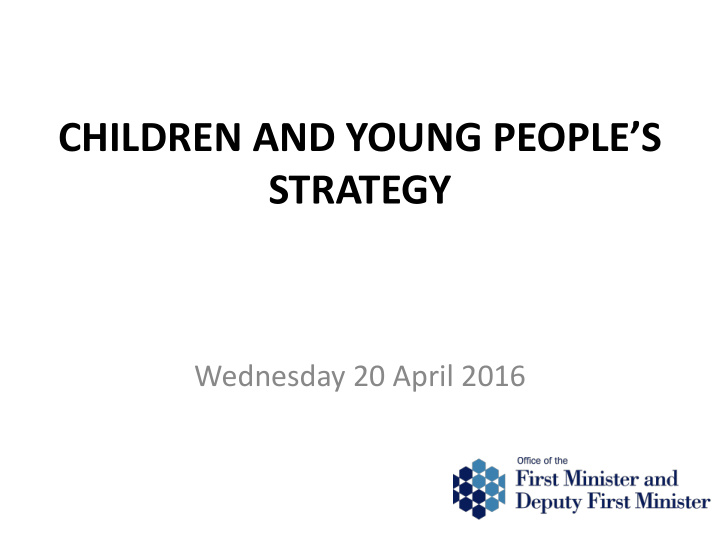



CHILDREN AND YOUNG PEOPLE’S STRATEGY Wednesday 20 April 2016
UPDATE POSITION • Project Board (Dept reps, NICCY, NISRA) • Review of previous Strategy • Analysis of UNCRC Alternative Reports / List of Issues • Series of Workshops/ One-to-one meetings • Met CYPSP Outcomes Groups • Met Departmental Policy Leads
REVIEW OF PREVIOUS STRATEGY • Strong in design, development and theory – weaker in implementation, monitoring and delivery. Strengths Weaknesses Cross-cutting and recognised need for collaborative Momentum decreased as funding reduced and working to tackle complex issues Departments reverted to working individually Helped break down ‘silo’ culture and encouraged Difficult to monitor given the range of other innovative thinking. interventions available. (other strategies / schemes) Considered barriers and prioritised areas of need. Actions were general and difficult to measure. Was long term and focussed on preventative Other strategies, whilst acknowledging CYP strategy measures / early interventions. did not necessarily align. Needs higher profile across Executive and link / Respect for the rights of children. influence other related strategies. Ambitious. Reporting not clear / what has been achieved?
REVIEW OF PREVIOUS STRATEGY – LESSONS LEARNED • Effective and robust monitoring system • Key cross-departmental priorities • How government and its stakeholders can work better and more closely • Key underlying principles: – outcomes focussed – rights based – evidence informed – child informed – designed with stakeholders
ASSESSMENT OF EXISTING INFORMATION • Consultation responses DSC for Children and Young People (January 2014) • UN Report - four Children’s Commissioners (2015) • NGO alternative report to UN (2015) • Young Persons report to UN ‘Our Lives in Our Words’ (July 2015) • Human Rights Commission UN report (July 2015) • UNCRC - List of Issues (November 2015) • Feedback from workshops/CYPSP/Departments • Engagement with Children and Parents
EMERGING THEMES • Fully implement the UNCRC so that all our children and young people are seen as “rights holders” • Empower and equip our children and young people to fulfil their potential as active citizens • Education on rights • Providing opportunities for children and young people to participate in policy development • Issues that affect the well-being of our children and young people including: • Mental health, Education, Employment, • Youth Justice issues, Child poverty, • Transitions, Negative stereotyping, • Disabled children issues • Homelessness • Looked after children • Parenting / families / Separation/ Divorce • Safety in own communities • Good relations • Play and leisure • Addiction • Neglect • Youth Work • Emerging issues • Cyber bullying • LGB children and young people • Transgender CYP • Newcomer children • FGM • Children of prisoners
Bigger Picture • UNCRC (Concluding Observations – June 2016) • Children’s Services Co -operation Act (8 well-being parameters) • NI Executive - Programme for Government • NI Executive - Children & Young People’s Strategy
C HILDREN ’ S S ERVICES C O - OPERATION A CT (N ORTHERN I RELAND ) 2015 • Within the Act the term ‘well - being’ is defined through using 8 general parameters. – Physical and mental health – Enjoyment of play and leisure – Learning and achieving – Living in safety and stability – Economic and environmental well being – Positive contribution to society – Respect of their rights – Promotion of good relations
PfG Framework Structure High Level Outcomes 10-15 succinct, accessible statements describing what we are trying to achieve. Key Indicators Perhaps about 3 per outcome – in key areas indicating progress towards the outcome. Taken in the round, show direction of travel. Progress Measures Providing information on how the actions are being delivered Key Actions (e.g. Children & Young People’s Strategy) Actions that will shift key indicators. Collaborative programme – subject to review in light of progress.
NOT A SINGLE ISSUE STRATEGY Not in education, employment or training Early Rural CYP years Travellers Disabled All Children and Young People Black, Lesbian, gay, minority, bisexual ethnic Looked after Transgender children Educational inequalites
HIGH LEVEL APPROACH • B ETTER OUTCOMES – What conditions for Children and Young People do we want? – How will we measure success? – What does the existing data / research say? – Who are the key stakeholders? – What actions can we take? • B ETTER CO - OPERATION – How can Government work together? – What arrangements / structures are needed? – Where would the pooling budgets / data sharing / shared resources be most effective? • B ETTER DELIVERY – How can we monitor progress? – How do we keep sector reps and CYP involved? – Where can we make revisions / improvements? – What new data do we need to improve delivery?
N EXT S TEPS • Testing emerging thoughts (NICCY Workshops) – Are we missing anything? • Analysis of the strategic outcomes. – Outcomes Based Approach – Collation of data • Improving co-operation. – What arrangements are required? • Formal Consultation on draft Strategy (Autumn 2016) • Executive Agreement (December 2016)
Recommend
More recommend